Backup Storage¶
Disk Management¶
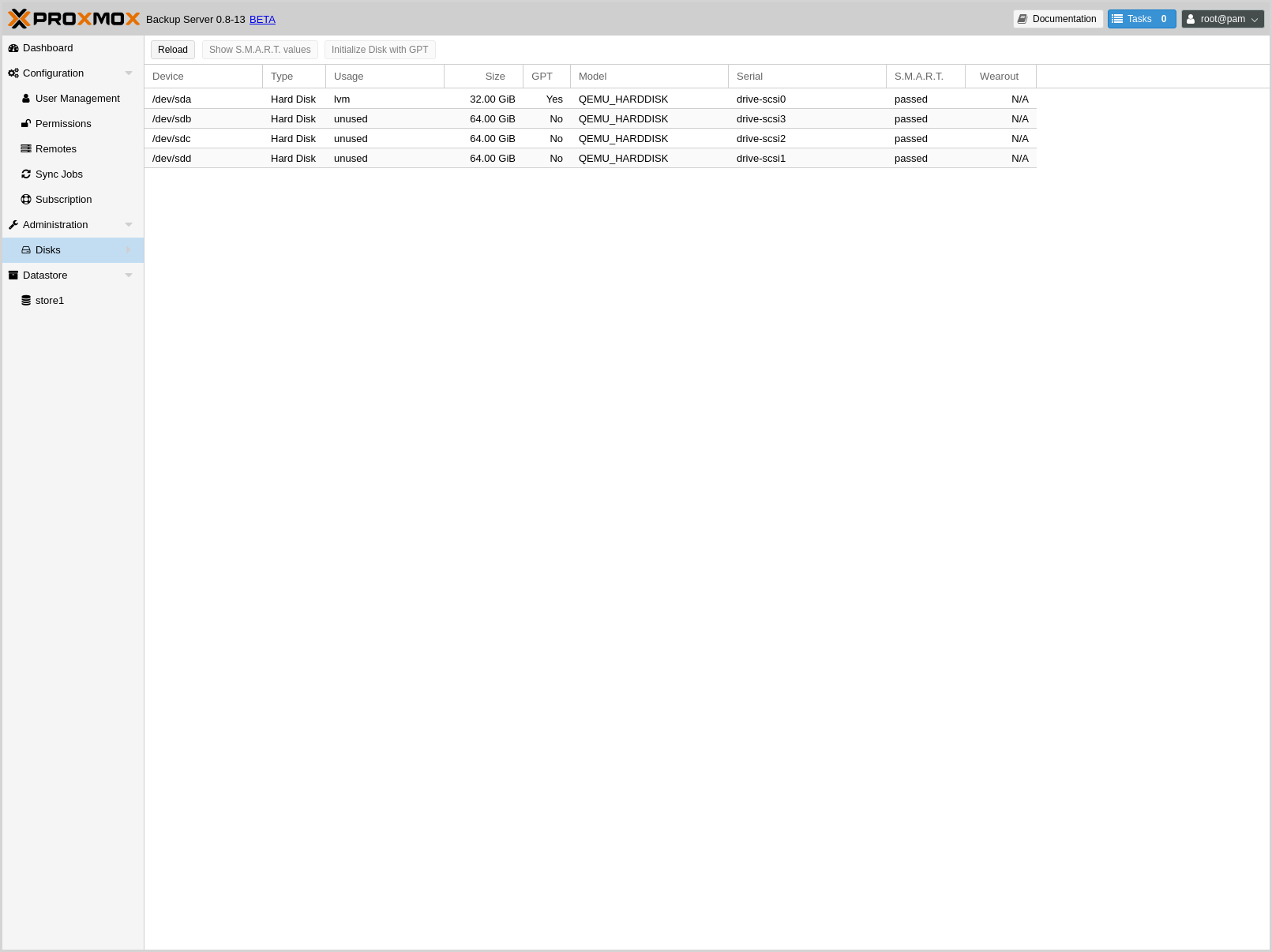
Proxmox Backup Server comes with a set of disk utilities, which are
accessed using the disk subcommand. This subcommand allows you to initialize
disks, create various filesystems, and get information about the disks.
To view the disks connected to the system, navigate to Administration ->
Disks in the web interface or use the list subcommand of
disk:
# proxmox-backup-manager disk list
┌──────┬────────┬─────┬───────────┬─────────────┬───────────────┬─────────┬────────┐
│ name │ used │ gpt │ disk-type │ size │ model │ wearout │ status │
╞══════╪════════╪═════╪═══════════╪═════════════╪═══════════════╪═════════╪════════╡
│ sda │ lvm │ 1 │ hdd │ 34359738368 │ QEMU_HARDDISK │ - │ passed │
├──────┼────────┼─────┼───────────┼─────────────┼───────────────┼─────────┼────────┤
│ sdb │ unused │ 1 │ hdd │ 68719476736 │ QEMU_HARDDISK │ - │ passed │
├──────┼────────┼─────┼───────────┼─────────────┼───────────────┼─────────┼────────┤
│ sdc │ unused │ 1 │ hdd │ 68719476736 │ QEMU_HARDDISK │ - │ passed │
└──────┴────────┴─────┴───────────┴─────────────┴───────────────┴─────────┴────────┘
To initialize a disk with a new GPT, use the initialize subcommand:
# proxmox-backup-manager disk initialize sdX
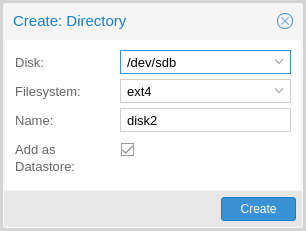
You can create an ext4 or xfs filesystem on a disk using fs
create, or by navigating to Administration -> Disks -> Directory in the
web interface and creating one from there. The following command creates an
ext4 filesystem and passes the --add-datastore parameter, in order to
automatically create a datastore on the disk (in this case sdd). This will
create a datastore at the location /mnt/datastore/store1:
# proxmox-backup-manager disk fs create store1 --disk sdd --filesystem ext4 --add-datastore true
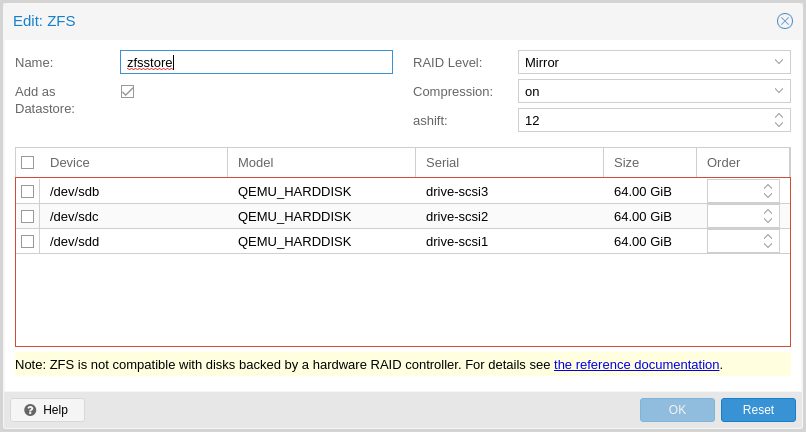
You can also create a zpool with various raid levels from Administration
-> Disks -> Zpool in the web interface, or by using zpool create. The command
below creates a mirrored zpool using two disks (sdb & sdc) and
mounts it under /mnt/datastore/zpool1:
# proxmox-backup-manager disk zpool create zpool1 --devices sdb,sdc --raidlevel mirror
Note
You can also pass the --add-datastore parameter here, to automatically
create a datastore from the disk.
You can use disk fs list and disk zpool list to keep track of your
filesystems and zpools respectively.
Proxmox Backup Server uses the package smartmontools. This is a set of tools used to monitor and control the S.M.A.R.T. system for local hard disks. If a disk supports S.M.A.R.T. capability, and you have this enabled, you can display S.M.A.R.T. attributes from the web interface or by using the command:
# proxmox-backup-manager disk smart-attributes sdX
Note
This functionality may also be accessed directly through the use of
the smartctl command, which comes as part of the smartmontools package
(see man smartctl for more details).
Datastore¶
A datastore refers to a location at which backups are stored. The current
implementation uses a directory inside a standard Unix file system (ext4,
xfs or zfs) to store the backup data.
Datastores are identified by a simple ID. You can configure this
when setting up the datastore. The configuration information for datastores
is stored in the file /etc/proxmox-backup/datastore.cfg.
Note
The File Layout requires the file system to support at least 65538
subdirectories per directory. That number comes from the 216
pre-created chunk namespace directories, and the . and .. default
directory entries. This requirement excludes certain filesystems and
filesystem configuration from being supported for a datastore. For example,
ext3 as a whole or ext4 with the dir_nlink feature manually disabled.
Datastore Configuration¶
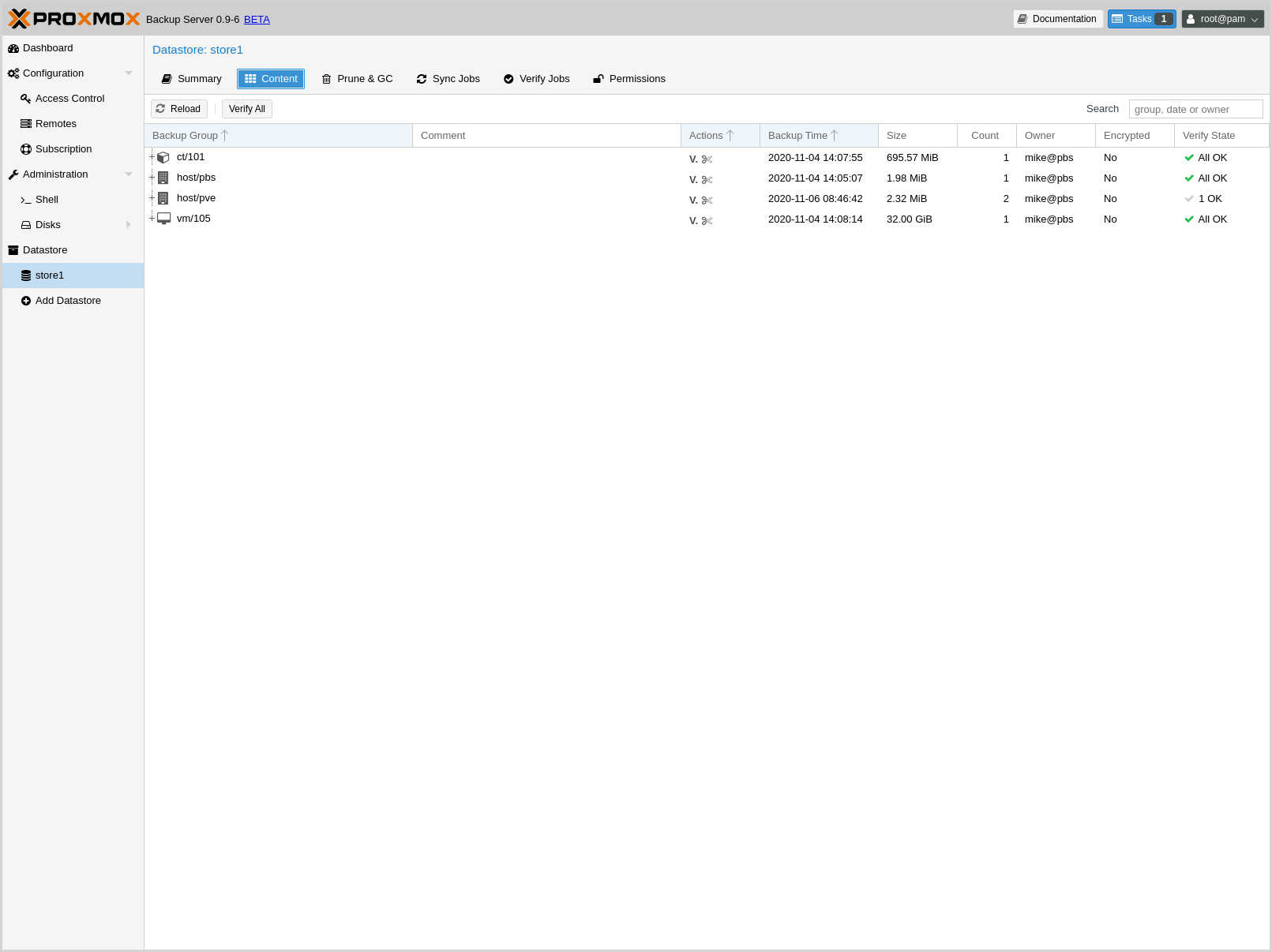
You can configure multiple datastores. Minimum one datastore needs to be
configured. The datastore is identified by a simple name and points to a
directory on the filesystem. Each datastore also has associated retention
settings of how many backup snapshots for each interval of hourly,
daily, weekly, monthly, yearly as well as a time-independent
number of backups to keep in that store. Pruning and Removing Backups and
garbage collection can also be configured to run
periodically based on a configured schedule (see Calendar Events) per datastore.
Creating a Datastore¶
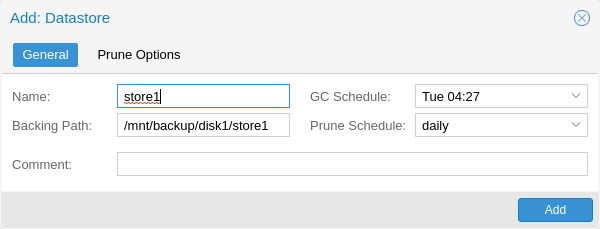
You can create a new datastore from the web interface, by clicking Add Datastore in the side menu, under the Datastore section. In the setup window:
- Name refers to the name of the datastore
- Backing Path is the path to the directory upon which you want to create the datastore
- GC Schedule refers to the time and intervals at which garbage collection runs
- Prune Schedule refers to the frequency at which pruning takes place
- Prune Options set the amount of backups which you would like to keep (see Pruning and Removing Backups).
- Comment can be used to add some contextual information to the datastore.
Alternatively you can create a new datastore from the command line. The
following command creates a new datastore called store1 on /backup/disk1/store1
# proxmox-backup-manager datastore create store1 /backup/disk1/store1
Managing Datastores¶
To list existing datastores from the command line run:
# proxmox-backup-manager datastore list
┌────────┬──────────────────────┬─────────────────────────────┐
│ name │ path │ comment │
╞════════╪══════════════════════╪═════════════════════════════╡
│ store1 │ /backup/disk1/store1 │ This is my default storage. │
└────────┴──────────────────────┴─────────────────────────────┘
You can change the garbage collection and prune settings of a datastore, by
editing the datastore from the GUI or by using the update subcommand. For
example, the below command changes the garbage collection schedule using the
update subcommand and prints the properties of the datastore with the
show subcommand:
# proxmox-backup-manager datastore update store1 --gc-schedule 'Tue 04:27'
# proxmox-backup-manager datastore show store1
┌────────────────┬─────────────────────────────┐
│ Name │ Value │
╞════════════════╪═════════════════════════════╡
│ name │ store1 │
├────────────────┼─────────────────────────────┤
│ path │ /backup/disk1/store1 │
├────────────────┼─────────────────────────────┤
│ comment │ This is my default storage. │
├────────────────┼─────────────────────────────┤
│ gc-schedule │ Tue 04:27 │
├────────────────┼─────────────────────────────┤
│ keep-last │ 7 │
├────────────────┼─────────────────────────────┤
│ prune-schedule │ daily │
└────────────────┴─────────────────────────────┘
Finally, it is possible to remove the datastore configuration:
# proxmox-backup-manager datastore remove store1
Note
The above command removes only the datastore configuration. It does not delete any data from the underlying directory.
File Layout¶
After creating a datastore, the following default layout will appear:
# ls -arilh /backup/disk1/store1
276493 -rw-r--r-- 1 backup backup 0 Jul 8 12:35 .lock
276490 drwxr-x--- 1 backup backup 1064960 Jul 8 12:35 .chunks
.lock is an empty file used for process locking.
The .chunks directory contains folders, starting from 0000 and taking hexadecimal values until ffff. These directories will store the chunked data after a backup operation has been executed.
# ls -arilh /backup/disk1/store1/.chunks
545824 drwxr-x--- 2 backup backup 4.0K Jul 8 12:35 ffff
545823 drwxr-x--- 2 backup backup 4.0K Jul 8 12:35 fffe
415621 drwxr-x--- 2 backup backup 4.0K Jul 8 12:35 fffd
415620 drwxr-x--- 2 backup backup 4.0K Jul 8 12:35 fffc
353187 drwxr-x--- 2 backup backup 4.0K Jul 8 12:35 fffb
344995 drwxr-x--- 2 backup backup 4.0K Jul 8 12:35 fffa
144079 drwxr-x--- 2 backup backup 4.0K Jul 8 12:35 fff9
144078 drwxr-x--- 2 backup backup 4.0K Jul 8 12:35 fff8
144077 drwxr-x--- 2 backup backup 4.0K Jul 8 12:35 fff7
...
403180 drwxr-x--- 2 backup backup 4.0K Jul 8 12:35 000c
403179 drwxr-x--- 2 backup backup 4.0K Jul 8 12:35 000b
403177 drwxr-x--- 2 backup backup 4.0K Jul 8 12:35 000a
402530 drwxr-x--- 2 backup backup 4.0K Jul 8 12:35 0009
402513 drwxr-x--- 2 backup backup 4.0K Jul 8 12:35 0008
402509 drwxr-x--- 2 backup backup 4.0K Jul 8 12:35 0007
276509 drwxr-x--- 2 backup backup 4.0K Jul 8 12:35 0006
276508 drwxr-x--- 2 backup backup 4.0K Jul 8 12:35 0005
276507 drwxr-x--- 2 backup backup 4.0K Jul 8 12:35 0004
276501 drwxr-x--- 2 backup backup 4.0K Jul 8 12:35 0003
276499 drwxr-x--- 2 backup backup 4.0K Jul 8 12:35 0002
276498 drwxr-x--- 2 backup backup 4.0K Jul 8 12:35 0001
276494 drwxr-x--- 2 backup backup 4.0K Jul 8 12:35 0000
276489 drwxr-xr-x 3 backup backup 4.0K Jul 8 12:35 ..
276490 drwxr-x--- 1 backup backup 1.1M Jul 8 12:35 .